Aohan Zeng
Does RLHF Scale? Exploring the Impacts From Data, Model, and Method
Dec 08, 2024
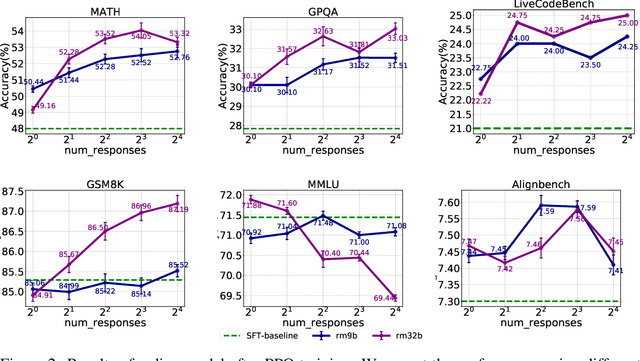
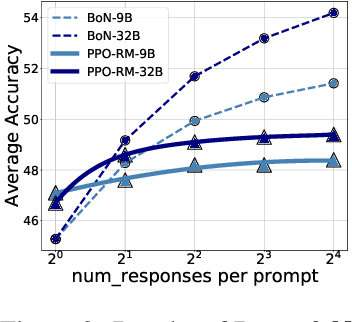
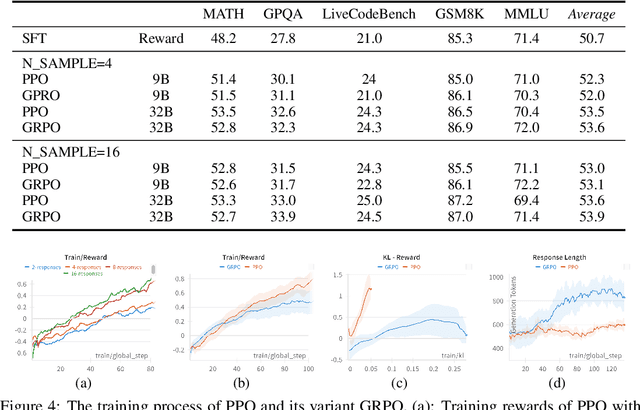
Abstract:This study explores the scaling properties of Reinforcement Learning from Human Feedback (RLHF) in Large Language Models (LLMs). Although RLHF is considered an important step in post-training of LLMs, its scaling potential is still largely unknown. We systematically analyze key components in the RLHF framework--model size, data composition, and inference budget--and their impacts on performance. Our findings show that increasing data diversity and volume improves reward model performance, helping process-supervision models scale better. For policy training, more response samples per prompt boost performance initially but quickly plateau. And larger reward models offer modest gains in policy training. In addition, larger policy models benefit less from RLHF with a fixed reward model. Overall, RLHF scales less efficiently than pretraining, with diminishing returns from additional computational resources. Based on these observations, we propose strategies to optimize RLHF performance within computational limits.
GLM-4-Voice: Towards Intelligent and Human-Like End-to-End Spoken Chatbot
Dec 03, 2024Abstract:We introduce GLM-4-Voice, an intelligent and human-like end-to-end spoken chatbot. It supports both Chinese and English, engages in real-time voice conversations, and varies vocal nuances such as emotion, intonation, speech rate, and dialect according to user instructions. GLM-4-Voice uses an ultra-low bitrate (175bps), single-codebook speech tokenizer with 12.5Hz frame rate derived from an automatic speech recognition (ASR) model by incorporating a vector-quantized bottleneck into the encoder. To efficiently transfer knowledge from text to speech modalities, we synthesize speech-text interleaved data from existing text pre-training corpora using a text-to-token model. We continue pre-training from the pre-trained text language model GLM-4-9B with a combination of unsupervised speech data, interleaved speech-text data, and supervised speech-text data, scaling up to 1 trillion tokens, achieving state-of-the-art performance in both speech language modeling and spoken question answering. We then fine-tune the pre-trained model with high-quality conversational speech data, achieving superior performance compared to existing baselines in both conversational ability and speech quality. The open models can be accessed through https://github.com/THUDM/GLM-4-Voice and https://huggingface.co/THUDM/glm-4-voice-9b.
Scaling Speech-Text Pre-training with Synthetic Interleaved Data
Nov 26, 2024Abstract:Speech language models (SpeechLMs) accept speech input and produce speech output, allowing for more natural human-computer interaction compared to text-based large language models (LLMs). Traditional approaches for developing SpeechLMs are constrained by the limited availability of unsupervised speech data and parallel speech-text data, which are significantly less abundant than text pre-training data, thereby limiting their scalability as LLMs. We propose a novel approach to scaling speech-text pre-training by leveraging large-scale synthetic interleaved data derived from text corpora, eliminating the need for parallel speech-text datasets. Our method efficiently constructs speech-text interleaved data by sampling text spans from existing text corpora and synthesizing corresponding speech spans using a text-to-token model, bypassing the need to generate actual speech. We also employ a supervised speech tokenizer derived from an automatic speech recognition (ASR) model by incorporating a vector-quantized bottleneck into the encoder. This supervised training approach results in discrete speech tokens with strong semantic preservation even at lower sampling rates (e.g. 12.5Hz), while still maintaining speech reconstruction quality. Starting from a pre-trained language model and scaling our pre-training to 1 trillion tokens (with 600B synthetic interleaved speech-text data), we achieve state-of-the-art performance in speech language modeling and spoken question answering, improving performance on spoken questions tasks from the previous SOTA of 13% (Moshi) to 31%. We further demonstrate that by fine-tuning the pre-trained model with speech dialogue data, we can develop an end-to-end spoken chatbot that achieves competitive performance comparable to existing baselines in both conversational abilities and speech quality, even operating exclusively in the speech domain.
VisualAgentBench: Towards Large Multimodal Models as Visual Foundation Agents
Aug 12, 2024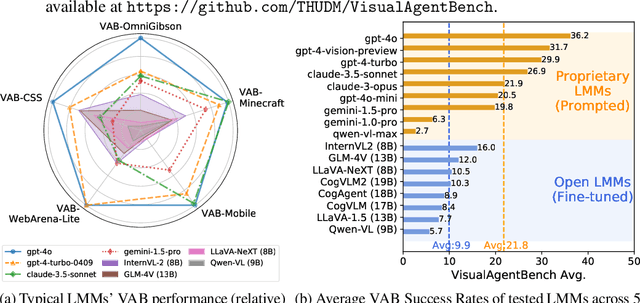
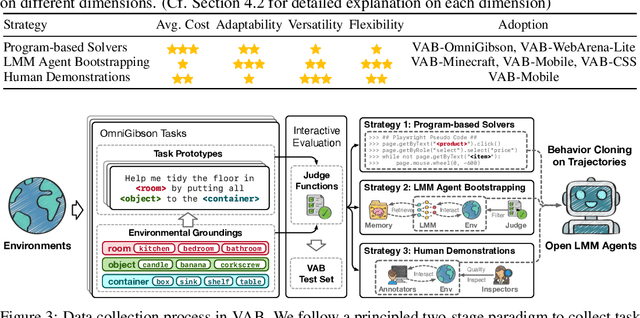

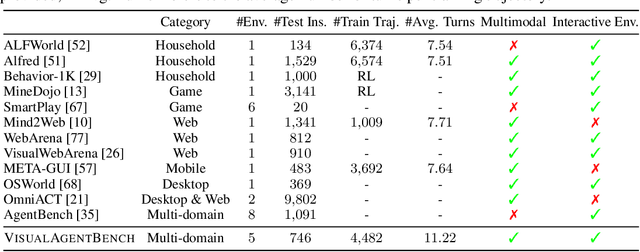
Abstract:Large Multimodal Models (LMMs) have ushered in a new era in artificial intelligence, merging capabilities in both language and vision to form highly capable Visual Foundation Agents. These agents are postulated to excel across a myriad of tasks, potentially approaching general artificial intelligence. However, existing benchmarks fail to sufficiently challenge or showcase the full potential of LMMs in complex, real-world environments. To address this gap, we introduce VisualAgentBench (VAB), a comprehensive and pioneering benchmark specifically designed to train and evaluate LMMs as visual foundation agents across diverse scenarios, including Embodied, Graphical User Interface, and Visual Design, with tasks formulated to probe the depth of LMMs' understanding and interaction capabilities. Through rigorous testing across nine proprietary LMM APIs and eight open models, we demonstrate the considerable yet still developing agent capabilities of these models. Additionally, VAB constructs a trajectory training set constructed through hybrid methods including Program-based Solvers, LMM Agent Bootstrapping, and Human Demonstrations, promoting substantial performance improvements in LMMs through behavior cloning. Our work not only aims to benchmark existing models but also provides a solid foundation for future development into visual foundation agents. Code, train \& test data, and part of fine-tuned open LMMs are available at \url{https://github.com/THUDM/VisualAgentBench}.
ChatGLM: A Family of Large Language Models from GLM-130B to GLM-4 All Tools
Jun 18, 2024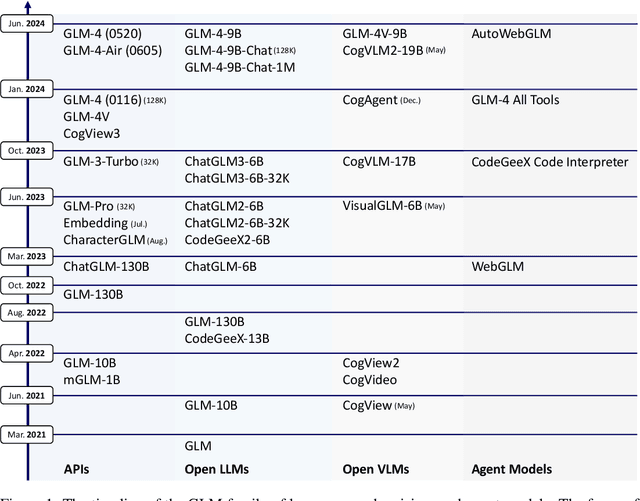
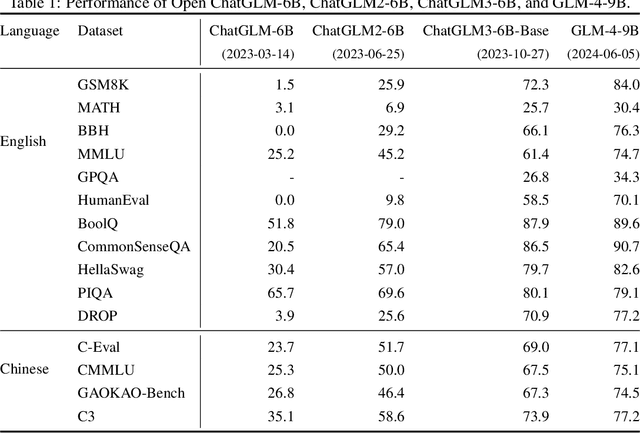
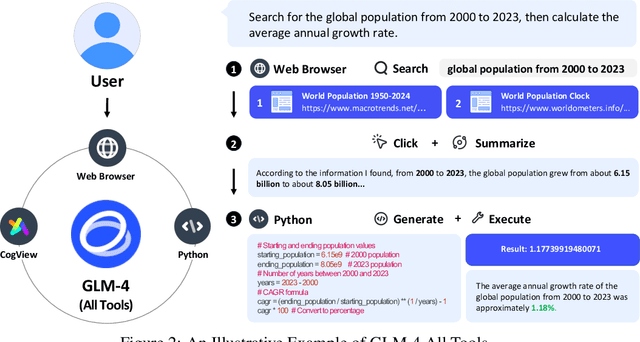
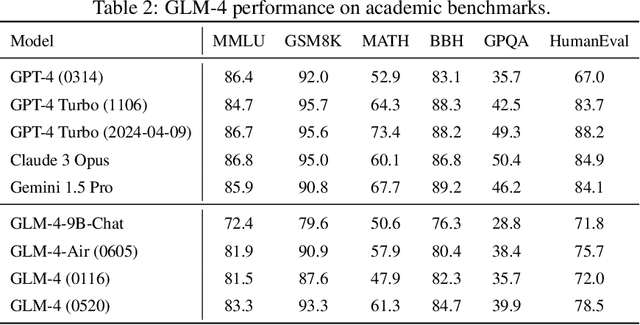
Abstract:We introduce ChatGLM, an evolving family of large language models that we have been developing over time. This report primarily focuses on the GLM-4 language series, which includes GLM-4, GLM-4-Air, and GLM-4-9B. They represent our most capable models that are trained with all the insights and lessons gained from the preceding three generations of ChatGLM. To date, the GLM-4 models are pre-trained on ten trillions of tokens mostly in Chinese and English, along with a small set of corpus from 24 languages, and aligned primarily for Chinese and English usage. The high-quality alignment is achieved via a multi-stage post-training process, which involves supervised fine-tuning and learning from human feedback. Evaluations show that GLM-4 1) closely rivals or outperforms GPT-4 in terms of general metrics such as MMLU, GSM8K, MATH, BBH, GPQA, and HumanEval, 2) gets close to GPT-4-Turbo in instruction following as measured by IFEval, 3) matches GPT-4 Turbo (128K) and Claude 3 for long context tasks, and 4) outperforms GPT-4 in Chinese alignments as measured by AlignBench. The GLM-4 All Tools model is further aligned to understand user intent and autonomously decide when and which tool(s) touse -- including web browser, Python interpreter, text-to-image model, and user-defined functions -- to effectively complete complex tasks. In practical applications, it matches and even surpasses GPT-4 All Tools in tasks like accessing online information via web browsing and solving math problems using Python interpreter. Over the course, we have open-sourced a series of models, including ChatGLM-6B (three generations), GLM-4-9B (128K, 1M), GLM-4V-9B, WebGLM, and CodeGeeX, attracting over 10 million downloads on Hugging face in the year 2023 alone. The open models can be accessed through https://github.com/THUDM and https://huggingface.co/THUDM.
ChatGLM-RLHF: Practices of Aligning Large Language Models with Human Feedback
Apr 03, 2024Abstract:ChatGLM is a free-to-use AI service powered by the ChatGLM family of large language models (LLMs). In this paper, we present the ChatGLM-RLHF pipeline -- a reinforcement learning from human feedback (RLHF) system -- designed to enhance ChatGLM's alignment with human preferences. ChatGLM-RLHF encompasses three major components: the collection of human preference data, the training of the reward model, and the optimization of policies. Throughout the process of integrating ChatGLM-RLHF into production, we encountered and addressed several unprecedented challenges. We introduce the strategies to mitigate reward variance for stabilized large-scale training, implement model parallelism with fused gradient-descent, and design regularization constraints to avoid catastrophic forgetting in LLMs. Experiments show that ChatGLM-RLHF brings significant improvements in alignment tasks compared to the supervised fine-tuned (SFT) version of ChatGLM. For instance, it achieves on average 15\% more wins against ChatGLM-SFT in Chinese alignment tasks. The work presents our practices of aligning LLMs with human preferences, offering insights into the challenges and solutions in RLHF implementations.
ChatGLM-Math: Improving Math Problem-Solving in Large Language Models with a Self-Critique Pipeline
Apr 03, 2024Abstract:Large language models (LLMs) have shown excellent mastering of human language, but still struggle in real-world applications that require mathematical problem-solving. While many strategies and datasets to enhance LLMs' mathematics are developed, it remains a challenge to simultaneously maintain and improve both language and mathematical capabilities in deployed LLM systems.In this work, we tailor the Self-Critique pipeline, which addresses the challenge in the feedback learning stage of LLM alignment. We first train a general Math-Critique model from the LLM itself to provide feedback signals. Then, we sequentially employ rejective fine-tuning and direct preference optimization over the LLM's own generations for data collection. Based on ChatGLM3-32B, we conduct a series of experiments on both academic and our newly created challenging dataset, MathUserEval. Results show that our pipeline significantly enhances the LLM's mathematical problem-solving while still improving its language ability, outperforming LLMs that could be two times larger. Related techniques have been deployed to ChatGLM\footnote{\url{https://chatglm.cn}}, an online serving LLM. Related evaluation dataset and scripts are released at \url{https://github.com/THUDM/ChatGLM-Math}.
Understanding Emergent Abilities of Language Models from the Loss Perspective
Mar 30, 2024Abstract:Recent studies have put into question the belief that emergent abilities in language models are exclusive to large models. This skepticism arises from two observations: 1) smaller models can also exhibit high performance on emergent abilities and 2) there is doubt on the discontinuous metrics used to measure these abilities. In this paper, we propose to study emergent abilities in the lens of pre-training loss, instead of model size or training compute. We demonstrate that the models with the same pre-training loss, but different model and data sizes, generate the same performance on various downstream tasks. We also discover that a model exhibits emergent abilities on certain tasks -- regardless of the continuity of metrics -- when its pre-training loss falls below a specific threshold. Before reaching this threshold, its performance remains at the level of random guessing. This inspires us to redefine emergent abilities as those that manifest in models with lower pre-training losses, highlighting that these abilities cannot be predicted by merely extrapolating the performance trends of models with higher pre-training losses.
APAR: LLMs Can Do Auto-Parallel Auto-Regressive Decoding
Jan 12, 2024



Abstract:The massive adoption of large language models (LLMs) demands efficient deployment strategies. However, the auto-regressive decoding process, which is fundamental to how most LLMs generate text, poses challenges to achieve efficient serving. In this work, we introduce a parallel auto-regressive generation method. By instruct-tuning on general domain data that contains hierarchical structures, we enable LLMs to independently plan their generation process and perform auto-parallel auto-regressive (APAR) generation, significantly reducing the number of generation steps. APAR alone can achieve up to 2x speed-up, and when combined with speculative decoding, the speed-up can reach up to 4x. In addition, APAR reduces the key-value cache consumption and attention computation during generation. This leads to a throughput increase of 20-70% and a latency reduce of 20-35% in high-throughput scenarios, compared to state-of-the-art serving frameworks.
xTrimoPGLM: Unified 100B-Scale Pre-trained Transformer for Deciphering the Language of Protein
Jan 11, 2024Abstract:Protein language models have shown remarkable success in learning biological information from protein sequences. However, most existing models are limited by either autoencoding or autoregressive pre-training objectives, which makes them struggle to handle protein understanding and generation tasks concurrently. We propose a unified protein language model, xTrimoPGLM, to address these two types of tasks simultaneously through an innovative pre-training framework. Our key technical contribution is an exploration of the compatibility and the potential for joint optimization of the two types of objectives, which has led to a strategy for training xTrimoPGLM at an unprecedented scale of 100 billion parameters and 1 trillion training tokens. Our extensive experiments reveal that 1) xTrimoPGLM significantly outperforms other advanced baselines in 18 protein understanding benchmarks across four categories. The model also facilitates an atomic-resolution view of protein structures, leading to an advanced 3D structural prediction model that surpasses existing language model-based tools. 2) xTrimoPGLM not only can generate de novo protein sequences following the principles of natural ones, but also can perform programmable generation after supervised fine-tuning (SFT) on curated sequences. These results highlight the substantial capability and versatility of xTrimoPGLM in understanding and generating protein sequences, contributing to the evolving landscape of foundation models in protein science.
 Add to Chrome
Add to Chrome Add to Firefox
Add to Firefox Add to Edge
Add to Edge